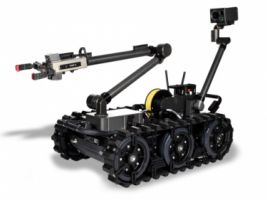Unmanned Ground Vehicle (UGV) Market - Global Growth, Trends, and Forecast to 2024 - ResearchAndMarkets.com
The "Unmanned Ground Vehicle (UGV) Market - Growth, Trends, and Forecast (2019 - 2024)" report has been added to ResearchAndMarkets.com's offering.
The market for the unmanned ground vehicle is anticipated to register a CAGR of over 8% during the forecast period.
There is a growing use of UGVs to carry counter-insurgency and combat operations. This is primarily to reduce human casualties in such situations. Increasing demand for UGVs for ISR missions. Demand for UGVs is also increasing for commercial applications, such as in the oil and gas sector, firefighting, and agriculture.
Several countries are significantly spending on the R&D of unmanned ground systems to overcome the challenges that are associated with such systems. Reliability of the systems and the need for improvement in the power supply to UGVs are some of the prominent challenges for the manufacturers of UGVs.
Scope of the Report
Unmanned ground vehicle is a land-based counterpart to remotely operate underwater vehicles and unmanned aerial vehicles. They are used in various missions where it may be inconvenient, dangerous, or impossible to have a human operator present.
Key Market Trends
Based on Application, the military segment will register the highest growth during the forecast period
The development of UGVs started way back in the 1960-70s by research institutions associated with the defense organizations. In recent years, armed forces of several countries have deployed UGVs for various missions. Recently, the Russian military revealed its combat-tested Uran-9 robot tank in Syria. Also, in 2015, Russia's Military Industry Committee announced its objective of deploying 30% of Russia's kinetic weapons on remote-control platforms by 2025.
UGVs have been successfully deployed for missions related to clearing mines and IEDs. Also, the role of UGVs are shifting toward addressing chemical, biological, radiological, nuclear, and explosive (CBRNE) threats. For instance, in July 2018, a collaboration agreement was signed between Croatian mine-clearing vehicle manufacturer DOK-ING and Israel Aerospace Industries (IAI) to produce a CBRNE UGV. Advancements in UGV capabilities and miniaturization of these vehicles will support the growth of UGVs in the military segment in the coming years.
North America and Europe are expected to generate huge demand for UGVs in the coming years
Major investments in the UGV market are expected from North America followed by Europe over the forecast period. Both Russia and the United States have progressed rapidly in the development of advanced unmanned ground systems. The popular UGVs in service with the US Armed Forces are the Foster-Miller TALON remotely operated vehicle series and PackBot military robots.
Recently, the US Army awarded a five-year contract to Endeavor Robotics to modernize and maintain the US Army's existing fleet of UGV platforms. The contract is worth USD 32 million. During the Army Warfighting Experiment 2018, the British Troops put four Milrem Robotics' and QinetiQ TITAN unmanned ground vehicles (UGVs) through three weeks of rigorous tests. The UGVs were used in a number of different roles with missions conducted in urban, open, and forested terrain. Similar developments are undergoing in Russia, India, Japan, France, and Estonia, among others.
Competitive Landscape
The market is highly fragmented with several major players. Most of the UGV procurement and development involves local players. However, due to the lack of technological expertise, some smaller local companies enter into a partnership with global players. Some of the prominent players in the market are Qinetiq, Oshkosh Defense, Lockheed Martin Corporation, iRobot Corporation, FLIR, Northrop Grumman Corporation, and BAE Systems, among others. Recently, FLIR completed the acquisition of Endeavor Robotics for USD 385 million. Product innovation will play a vital role for the success of any UGV manufacturer.
Key Topics Covered:
1 INTRODUCTION
1.1 Study Deliverables
1.2 Study Assumptions
1.3 Scope of the Study
2 RESEARCH METHODOLOGY
3 EXECUTIVE SUMMARY
4 MARKET DYNAMICS
4.1 Market Overview
4.2 Market Drivers
4.3 Market Restraints
4.4 Industry Attractiveness - Porter's Five Forces Analysis
4.4.1 Threat of New Entrants
4.4.2 Bargaining Power of Buyers/Consumers
4.4.3 Bargaining Power of Suppliers
4.4.4 Threat of Substitute Products
4.4.5 Intensity of Competitive Rivalry
5 MARKET SEGMENTATION
5.1 Application
5.1.1 Military
5.1.2 Commercial
5.2 Mobility
5.2.1 Wheeled
5.2.2 Tracked
5.2.3 Legged
5.2.4 Hybrid
5.3 Mode of Operation
5.3.1 Tethered
5.3.2 Tele-operated
5.3.3 Autonomous
5.4 Geography
5.4.1 North America
5.4.2 Europe
5.4.3 Asia-Pacific
5.4.4 South America
5.4.5 Middle East & Africa
6 COMPETITIVE LANDSCAPE
6.1 Mergers and Acquisitions, Joint Ventures, Collaborations, and Agreements
6.2 Vendor Market Share
6.3 Strategies Adopted by Leading Players
6.4 Company Profiles
6.4.1 Endeavor Robotics (FLIR Systems)
6.4.2 Qinetiq
6.4.3 Oshkosh Defense, LLC
6.4.4 Lockheed Martin Corporation
6.4.5 Northrop Grumman Corporation
6.4.6 Harris Corporation
6.4.7 ASELSAN A..
6.4.8 Rheinmetall AG
6.4.9 BAE Systems
6.4.10 ICOR Technology
6.4.11 DOK-ING
6.4.12 Roboteam*
7 MARKET OPPORTUNITIES AND FUTURE TRENDS
For more information about this report visit https://www.researchandmarkets.com/r/cn196i
View source version on businesswire.com: https://www.businesswire.com/news/home/20190527005235/en/







